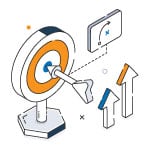The Ultimate Checklist for Accurate Lead Scoring

Lead scoring is an intricate dance of ranking sales leads. It is more than just sorting them out and going above and beyond to find the perfect match between a lead and its ideal follow-up. This specialized system not only benefits marketing and sales professionals but also gives valuable insights into each prospect’s purchasing journey.
Defining lead scores is a lot like constructing a bridge between marketing and sales teams. Together, they work hand in hand to establish a shared understanding of what constitutes a high-quality lead. Moreover, lead scoring ensures that the most promising leads receive immediate attention. By prioritizing leads based on their revenue potential and buyer readiness, lead scoring becomes the ultimate guide in seizing the best opportunities at the right time.

In today’s business landscape, the pursuit of achieving more with less has become a fundamental mantra for organizations, and its impact can be felt across all levels of the company.
Let’s consider the demands placed on your marketing team: How do you effectively channel all those leads to the sales department?
Typically, marketing organizations compile extensive lists of names or upload them to the sales database, hoping that the sales team will make the necessary calls. However, this approach often leads to frustration, with salespeople quickly giving up and dismissing the leads as worthless. Consequently, the blame game begins.
Modern lead scoring transforms lead prioritization from a subjective process to an analytical and scientific approach that is easily manageable and cost-effective. By implementing modern lead scoring, you can guide your sales team’s efforts in the most efficient and cost-effective manner possible, as leads are prioritized based on their fit with the prospect’s profile and level of interest.

How Lead Scoring Has Evolved in the Past Few Years
If you ask about the lead scoring methods sales and marketing executives across 100 companies employ, you will see that 99 of them swear by the BANT acronym. According to this widely adopted definition, a lead must possess the budget(B), authority(A), need(N), and timeline(T) for purchase to be deemed qualified. This framework has been the norm for the past decade.
But today, buyers do their own research before they establish factors like budget and timeline. They delve into technical briefs, study case studies, seek validation from peers, and even turn to social media to tap into collective experiences.
Unfortunately, salespeople often remain oblivious to these intricate buyer behaviors.
To adapt to the evolving purchasing process, advanced lead scoring systems rely on a wide range of data points to assess lead quality.
- While explicit criteria such as job title, company revenue, and industry may indicate a potential match, it is the implicit behavioral cues that hold the key to deciphering genuine buying interest.
- This digital body language provides valuable insights into a lead’s level of engagement with your company. In fact, the prevailing trend emphasizes the importance of behavioral patterns—how frequently a prospect interacts with your company and its content. This behavior often proves to be a more potent indicator than the inaccurate data collected through phone calls or website forms.
In this eBook, we dive into the exciting world of modern lead-scoring practices that are revolutionizing the way businesses identify and prioritize their leads. Keep reading to delve into these innovative lead-scoring practices that can potentially:
- Unlock the potential to supercharge your sales and marketing efforts.
- Equip you with the knowledge and tools needed to stay ahead in the competitive landscape of lead generation and conversion.
- Transform the way you score and prioritize leads for maximum business impact.

LEAD SCORING STRATEGY 1
Account-Based Marketing (ABM)

Here’s how ABM has transformed lead scoring practices, along with some valuable tips for integrating ABM into your own scoring methodology.
The Power of Personalization
ABM emphasizes personalized engagement with key accounts, focusing on building meaningful relationships with decision-makers and influencers. This shift from a mass marketing approach to a highly targeted and personalized strategy has significant implications for lead scoring.
Instead of solely relying on generic lead attributes, ABM encourages the evaluation of account-specific data points, such as account size, industry, and strategic fit. By incorporating these factors into your lead scoring model, you can effectively identify and prioritize leads that align with your ideal customer profile.
Collaboration Between Sales and Marketing
ABM fosters close collaboration between sales and marketing teams, as they work together to define target accounts and develop personalized strategies. This collaboration extends to lead scoring, where sales and marketing jointly determine the criteria that indicate lead quality.
Engagement Metrics and Intent Signals
ABM emphasizes tracking and analyzing the engagement metrics and intent signals of target accounts. These metrics include website visits, content consumption, and interactions with marketing campaigns. By analyzing this data, you can gain valuable insights into account-level buying signals and identify leads that demonstrate a genuine interest in your offerings.
Personalized Content and Nurturing
ABM emphasizes the creation of tailored, highly relevant content for target accounts throughout their buyer’s journey. By delivering personalized content that addresses the specific pain points and challenges of each account, you can nurture leads effectively and move them closer to conversion.
For example, Marketo, a leading marketing automation platform, experienced a 20% increase in its win rate and a 33% increase in pipeline generation after implementing personalized ABM campaigns.
Marketo, a leading marketing automation platform, experienced a 20% increase in its win rate and a 33% increase in pipeline generation after implementing personalized ABM campaigns.
LEAD SCORING STRATEGY 2
Behavioral Scoring
Understanding how potential customers engage with your brand, interact with content, and navigate their buyer’s journey provides invaluable insights that can drive effective lead-scoring strategies. Let’s explore the significance of behavioral scoring and find ways to set up your own behavioral scoring models.
The Power of Behavioral Insights
Tracking prospect behavior offers a window into their interests, preferences, and level of engagement. By monitoring actions such as website visits, content downloads, email opens, click-through rates, social media interactions, and event attendance, you gain a deeper understanding of each lead’s intent and buying readiness.
Data-Driven Lead Scoring Models
When setting up behavioral scoring models, leverage data-driven approaches to ensure accuracy and reliability. Start by identifying the key behaviors that indicate a prospect’s interest and readiness to make a purchase. Assign scores to each behavior based on their significance and align them with your sales funnel stages.
Segmentation for Personalized Experiences
Behavioral scoring allows for effective lead segmentation, enabling personalized experiences tailored to each prospect’s preferences and interests. By grouping leads based on their behaviors, you can deliver targeted content and nurture them based on their specific needs. This approach enhances engagement, builds trust, and increases the likelihood of conversion.
Automated Tracking and Scoring
Leverage marketing automation and CRM systems to automate the tracking and scoring of prospect behavior. By integrating these tools, you can collect real-time data and trigger actions based on predefined behavior thresholds. This automation streamlines the lead scoring process, reduces manual effort, and ensures timely and accurate scoring.
For example, Salesforce, a renowned CRM platform, reported a 10% increase in team productivity and a 27% increase in lead conversion rates by implementing automated behavioral scoring.
Salesforce, a renowned CRM platform, reported a 10% increase in team productivity and a 27% increase in lead conversion rates by implementing automated behavioral scoring.
LEAD SCORING STRATEGY 3
Predictive Scoring
Predictive scoring is a powerful lead-scoring tool that revolutionizes the way businesses identify and prioritize their potential customers. By leveraging advanced predictive modeling techniques, you can significantly enhance the accuracy of your lead-scoring processes.
How Does Predictive Modeling Improve Lead-Scoring Accuracy?
Harnessing Historical Data
Predictive scoring relies on analyzing vast amounts of historical data to identify patterns and correlations. By examining past customer behavior, such as purchase history, interactions, and demographic information, predictive models can accurately predict the likelihood of leads converting into customers.
Incorporating External Data
Predictive models can be enriched by incorporating external data sources, such as social media activity, industry trends, or economic indicators. This additional information enhances the accuracy of lead scoring by providing a broader context for predicting customer behavior.
Identifying Hidden Patterns
Predictive scoring algorithms are designed to uncover hidden patterns and relationships in data that may not be immediately apparent. By detecting these patterns, businesses can gain valuable insights into lead behavior and make more informed decisions.
Tips for Implementing Predictive Scoring
Data Quality and Preparation
Accurate predictive scoring heavily relies on high-quality data. To ensure success, it’s crucial to clean and preprocess the data, remove duplicates, correct errors, and fill in missing values. Additionally, considering the relevance and recency of the data is essential for accurate predictions.
Choosing the Right Predictive Modeling Technique
Selecting the appropriate predictive modeling technique is crucial for achieving accurate lead scoring. Different algorithms, such as logistic regression, decision trees, or neural networks, have distinct strengths and weaknesses.
Regular Model Evaluation and Iteration
Predictive scoring is an ongoing process that requires continuous evaluation and iteration. It’s essential to monitor the model’s performance, validate its predictions against new data, and make necessary adjustments to ensure its accuracy over time.
In a nutshell, predictive scoring offers businesses a powerful tool to improve lead-scoring accuracy, leading to more effective resource allocation and higher conversion rates.

Predictive lead scoring improves lead scoring accuracy by examining past customer behavior, incorporating external data sources (like social media and industry trends), and identifying hidden patterns that might not otherwise be immediately apparent.
LEAD SCORING STRATEGY 4
Machine Learning
Machine learning plays a vital role in lead scoring, revolutionizing the way businesses identify and prioritize potential customers. By leveraging the power of advanced algorithms, machine learning enables companies to extract valuable insights from their data and make more accurate predictions.
Role of Machine Learning in Lead Scoring
Automated Pattern Recognition
Machine learning algorithms excel at recognizing complex patterns and relationships within large datasets. By analyzing historical customer data, these algorithms can identify subtle indicators and behaviors that are highly predictive of conversion. This automated pattern recognition allows for more accurate lead scoring, ensuring that the right leads are prioritized.
Continuous Learning and Adaptation
Machine learning models can adapt and improve over time by continuously learning from new data. As more data becomes available, these models can update their understanding of customer behavior and adjust lead scores accordingly. This adaptability ensures that lead scoring remains accurate even as customer dynamics change.
Scalability and Efficiency
Machine learning enables automated and scalable lead-scoring processes. By automating the analysis of vast amounts of data, machine learning algorithms can handle large lead databases efficiently. This scalability allows businesses to score leads quickly and accurately, even when dealing with high volumes of leads.
Tips for Leveraging Machine Learning to Improve Lead Scoring
Data Quality and Feature Engineering
High-quality data and carefully engineered features are crucial for effective machine learning-based lead scoring. They ensure that the data used for training and prediction is clean, accurate, and representative of the target population. Additionally, feature engineering involves selecting and creating relevant features that capture the most predictive information.
Model Selection and Validation
You can choose the appropriate machine learning model for lead scoring based on the specific requirements of your business. By evaluating different algorithms, such as logistic regression, random forests, or gradient boosting, and selecting the one that offers the best balance between accuracy and interpretability.
Ongoing Monitoring and Iteration
With continuous performance monitoring of your machine learning model, you can make necessary iterations. By assessing the accuracy and effectiveness of lead scores by comparing them against actual conversion outcomes you can identify areas of improvement, such as misclassified leads or changing customer behaviors, and update the model accordingly.

By leveraging the power of advanced algorithms, machine learning enables companies to extract valuable insights from their data and make more accurate predictions.
LEAD SCORING STRATEGY 5
Data Management
Effective data management is essential for accurate lead scoring. The quality of data directly impacts the reliability and effectiveness of lead-scoring models. This section highlights the importance of data quality in lead scoring and provides practical tips for managing data effectively to ensure accurate lead scoring.
Importance of Data Quality in Lead Scoring
Reliable Predictive Insights
High-quality data is the foundation of accurate lead scoring. Inaccurate or incomplete data can lead to flawed predictions and misidentification of high-value leads. Clean and reliable data ensure that the insights generated from predictive models are trustworthy and actionable.
Reduced Bias and Inequality
Biased data can perpetuate discrimination and inequalities in lead scoring. If data is skewed towards a particular demographic or excludes certain groups, it can result in biased predictions. Ensuring data quality includes addressing biases and striving for fairness in lead-scoring processes.
Efficient Resource Allocation
Inaccurate or redundant data can lead to inefficient resource allocation. When lead scoring models are based on poor-quality data, businesses may waste time and resources on leads that are unlikely to convert. High-quality data enables efficient allocation of resources, focusing efforts on leads with the highest probability of conversion.
Tips for Managing Data Effectively in Lead Scoring
Data Cleaning and Validation
Regularly clean and validate your data to ensure accuracy and reliability. This includes removing duplicates, correcting errors, and verifying the integrity of the data. Implement automated processes to streamline data cleaning and establish protocols for ongoing data validation.
Data Integration
You can integrate data from multiple sources to gain a comprehensive view of leads. Combining data from various channels, such as website interactions, customer relationship management (CRM) systems, and social media, provides a more holistic understanding of leadership behavior and improves lead-scoring accuracy.
Data Governance and Security
Implement robust data governance practices to ensure data quality, privacy, and security. By establishing data management policies, defining data ownership, and implementing secure storage and access controls it becomes easier to adhere to data governance principles that build trust in lead-scoring processes and protects sensitive customer information.

The quality of data directly impacts the reliability and effectiveness of lead-scoring models. Regularly clean and validate your data. Ensure data quality, privacy, and security in your data management policies.

Successful Brands That Have Mastered Modern Lead Scoring Practices
Netflix’s Personalized Recommendations
Netflix, the popular streaming platform, leverages data management to enhance its lead-scoring capabilities for personalized content recommendations. By collecting and analyzing user data, including viewing history, ratings, and preferences, Netflix builds comprehensive user profiles.
These profiles are then used to generate highly accurate recommendations, increasing user engagement and retention. The success of Netflix’s recommendation system highlights the importance of effective data management in delivering personalized experiences and improving lead-scoring accuracy.

Amazon’s Product Recommendations
Amazon, the global e-commerce giant, relies on data management to power its sophisticated product recommendation engine. By collecting and analyzing vast amounts of customer data, including purchase history, browsing behavior, and demographic information, Amazon generates personalized product recommendations.
These recommendations significantly improve lead scoring, increasing the likelihood of conversion and driving customer satisfaction. Amazon’s use case demonstrates how effective data management can drive revenue growth and customer loyalty through improved lead scoring.

Salesforce’s Sales Cloud
Salesforce, a leading customer relationship management (CRM) platform, offers Sales Cloud, a comprehensive solution for lead management and scoring. Salesforce’s success lies in its robust data management capabilities, allowing businesses to centralize and analyze customer data effectively.
By leveraging machine learning algorithms, Sales Cloud provides intelligent lead scoring, enabling sales teams to prioritize high-potential leads and close deals more efficiently. Salesforce’s case study emphasizes the crucial role of data management in optimizing lead-scoring processes and driving sales effectiveness.
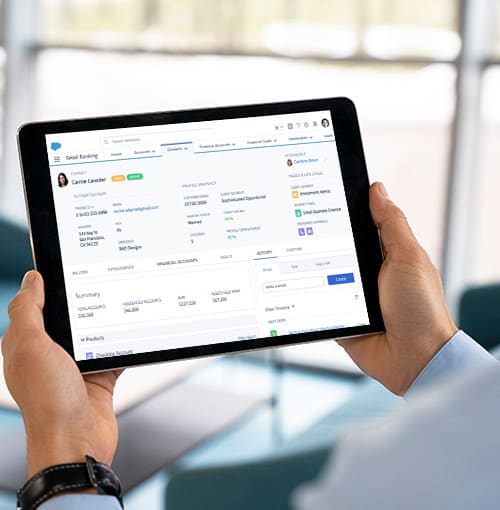


Creating the Ultimate Checklist for Accurate Lead Scoring
Effective data management is paramount for accurate lead scoring. Data quality ensures reliable predictions, reduces biases, and enables efficient resource allocation.
By implementing data cleaning and validation processes, integrating data from various sources, and establishing data governance practices, businesses can optimize lead scoring accuracy.
With that in mind, let us move forward and identify the key components of creating the ultimate checklist for accurate lead scoring. Let’s begin.

Define Your Ideal Customer Profile (ICP)
The ICP is a detailed description of the type of customer who would derive the most value from your product or service. It helps you identify and prioritize leads that have the highest potential for conversion and long-term success.
Importance of ICP in Lead Scoring
ICP plays a crucial role in lead scoring because it allows you to focus your resources on leads that align with your target market. By accurately identifying leads that fit your ICP, you can prioritize them and allocate your sales and marketing efforts more effectively, increasing the likelihood of successful conversions and reducing wasted resources.
How to Define Your ICP
-
Analyze Your Existing Customer Base
Examine your current customers and identify patterns, commonalities, and characteristics shared among the most successful and satisfied customers.
-
Do Your Market Research
Study the market to understand industry trends, pain points, and challenges faced by your potential customers? This research will help you align your product or service with their needs.
-
Gather Feedback from Sales and Customer Success Teams
Engage with your sales and customer success teams to gain insights into the types of customers they find most successful and the characteristics they look for in a lead.
-
Use Data Analysis
Leverage data analytics tools to gather quantitative data on your customers, such as demographics, firmographics, purchase history, and behavior patterns. This data can help identify commonalities among your best customers.

Key Characteristics to Consider When Defining Your ICP
- Demographics: These include factors like age, gender, location, company size, industry, and job title that align with your target market.
- Firmographics: To evaluate company-specific details, including revenue, employee count, geographical location, technology stack, and growth stage.
- Pain Points and Challenges: Helps you understand the common challenges, pain points, and goals your ideal customers have, and how your product or service can address them.
- Buying Behavior: Analyzes the decision-making process, budgetary considerations, and the average sales cycle length for your ideal customers.
- Fit with Your Solution: Determines whether the lead has a genuine need for your product or service and if it aligns with their goals and objectives

By accurately identifying leads that fit your ICP, you can prioritize them and allocate your sales and marketing efforts more effectively, increasing the likelihood of successful conversions and reducing wasted resources.

Developing a Scoring System
When it comes to lead-scoring there are a few primary types of systems at play. These include:
- Explicit Scoring: It involves assigning scores based on specific characteristics and actions provided by the leads themselves, such as job title, company size, or website visits.
- Implicit Scoring: Here you assign scores based on observed behaviors and interactions with your brand, such as email opens, website engagement, or content downloads.
- Predictive Scoring: It includes utilizing advanced algorithms and machine learning techniques to predict a lead’s likelihood of conversion based on historical data and patterns.
Building a Scoring System that Aligns with Your Business Goals
Define your objectives
Clearly identify the primary goals of your lead scoring system, such as prioritizing leads for sales, identifying high-value prospects, or improving marketing efficiency.
Collaborate with stakeholders
Involve your sales, marketing, and customer success teams to gather insights and ensure alignment between the scoring system and your overall business strategy.
Determine scoring thresholds
Set specific thresholds that indicate when a lead is considered qualified or ready to be passed to sales, based on your unique business requirements.
Defining Scoring Criteria and Assigning Values
Identify Important Attributes
Determine the key characteristics and behaviors that indicate a lead’s fit and engagement level with your product or service.
Assign Score Values
Assign numerical values to different attributes and behaviors based on their relative importance and their correlation with conversion and revenue generation.
Weighting Factors
Apply weightings to different attributes and behaviors to reflect their significance in the overall lead scoring calculation.
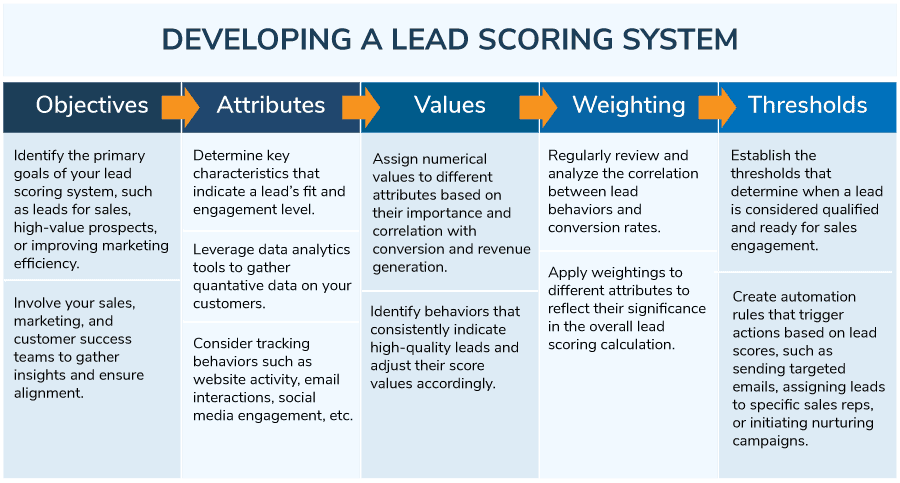

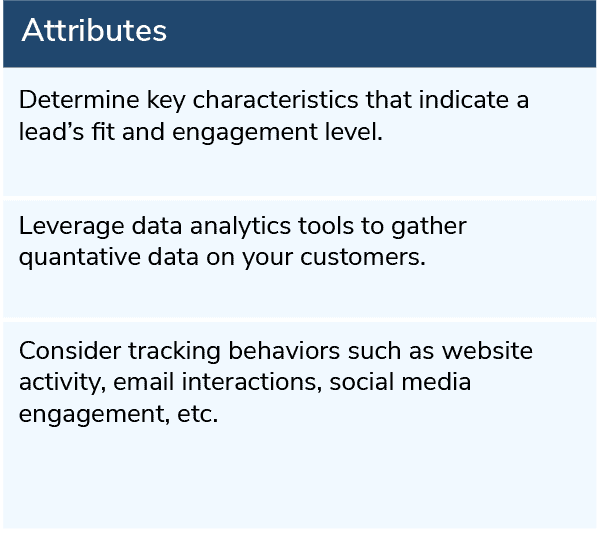


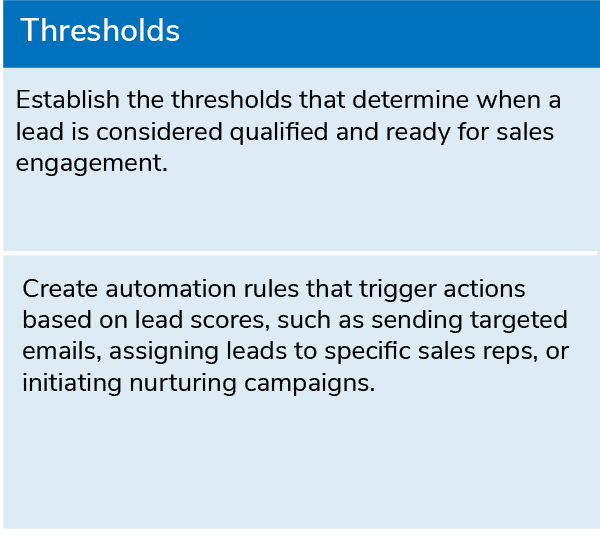

Importance of Tracking and Analyzing Lead Behavior in Lead Scoring
Behavioral data provides valuable insights into a lead’s level of interest, engagement, and intent, allowing you to prioritize and personalize your interactions accordingly. It helps you understand which marketing campaigns, channels, or content resonates most with your leads, enabling you to optimize your strategies and resources. Tracking and analyzing lead behavior can uncover patterns and trends that indicate a lead’s readiness to buy, allowing your sales team to focus on leads with higher conversion potential.
Key Behaviors to Track and Analyze
- Website Activity: Monitor page visits, content downloads, time spent on specific pages, or any other relevant engagement metrics.
- Email Interactions: Track email opens, clicks, conversions, and responses to gauge interest and responsiveness.
- Social Media Engagement: Monitor likes, shares, comments, and direct interactions on social media platforms.
- Event Attendance: Track attendance and participation in webinars, conferences, or other events organized by your company.
- Form Submissions: Evaluate the completion of forms, surveys, or requests for demos, indicating a higher level of interest.
How to Use Behavioral Data to Adjust Scoring Criteria
- Regularly review and analyze the correlation between lead behaviors and conversion rates.
- Identify behaviors that consistently indicate high-quality leads and adjust their score values accordingly.
- Monitor changes in the market or buyer behavior that may require updating or adding new scoring criteria.
- Continuously iterate and refine your scoring system based on the insights gained from behavioral data analysis, ensuring it remains aligned with your business goals and the evolving needs of your target audience.

Implement and Test Your Scoring Model
Now that you have a clear understanding of the concepts mentioned above, let’s look at the steps you can follow to implement your scoring model in your marketing automation platform.
Set Up Your Scoring Criteria
Configure the attributes, behaviors, and values in your marketing automation platform that align with your scoring model.
Define Lead Qualification Thresholds
Establish the thresholds that determine when a lead is considered qualified and ready for sales engagement.
Map Scoring Values
Map the scoring values to the corresponding actions or attributes in your marketing automation platform.
Implement Automation Rules
Create automation rules that trigger actions based on lead scores, such as sending targeted emails, assigning leads to specific sales reps, or initiating nurturing campaigns.
How to Test and Refine Your Scoring Model
Start With A Pilot Phase
Begin by implementing the scoring model on a smaller subset of leads to observe its effectiveness and make adjustments if needed.
Monitor Lead Behavior And Outcomes
Track the conversion rates and sales outcomes of the leads in different score ranges to validate the accuracy of your scoring model.
Analyze Feedback From Sales
Gather feedback from your sales team regarding the quality and alignment of leads they receive, and make adjustments accordingly.
Continuously Refine And Iterate
Regularly review and update your scoring model based on data analysis and feedback from both marketing and sales teams.
Best Practices for Ongoing Monitoring and Optimization
Regularly Review Scoring Criteria
Assess the relevance and effectiveness of the scoring criteria by analyzing the correlation between scores and conversion outcomes.
Monitor Conversion Rates
Track the conversion rates of leads across different score ranges to identify patterns and trends.
Analyze Lead Behavior
Continuously analyze lead behavior data to identify new patterns or behaviors that may indicate a lead’s likelihood of conversion.
Collaborate Between Marketing And Sales
Maintain open communication and collaboration between marketing and sales teams to gather insights, share feedback, and refine the scoring model as needed.

Integrate Lead Scoring with Sales Processes
In the bustling world of sales, where time is of the essence and every opportunity counts, the integration of lead scoring emerges as a beacon of efficiency and productivity. With lead scoring, sales teams can navigate the labyrinth of potential clients with precision and purpose.
By assigning scores that reflect the potential of each lead, sales efforts can be laser-focused on those with the highest probability of conversion, allowing teams to prioritize their resources effectively.
Beyond mere prioritization, integrating lead scoring infuses sales interactions with a personal touch. Armed with the behavioral insights gleaned from lead scores, sales reps gain an intimate understanding of each lead’s desires and preferences.
Moreover, the integration of lead scoring revolutionizes lead routing. Gone are the days of manual deliberation and guesswork when determining the ideal sales rep for a lead. Through automation, leads are deftly directed to the most appropriate sales reps or teams based on their scores.

In the bustling world of sales, where time is of the essence and every opportunity counts, the integration of lead scoring emerges as a beacon of efficiency and productivity.

How to Use Lead Scores to Prioritize and Route Leads to Sales Reps
Like an architect crafting the blueprints of success, one must establish lead score thresholds as the foundation. These thresholds lead to a point where a lead is deemed qualified for sales engagement, triggering a cascade of appropriate follow-up actions.
Implementing lead routing rules is the next stroke on the canvas of lead-scoring mastery. It involves configuring customer relationship management (CRM) systems or sales automation platforms to orchestrate effective lead distribution.
With attention to detail, the system automatically guides leads to their sales representatives, guided by their scores. With access to relevant insights, sales reps can effortlessly prioritize their interactions, tailoring their approaches based on the lead’s score and behavioral patterns.
Armed with this knowledge, they enter each conversation with confidence, ready to provide customized solutions and address the prospect’s specific pain points.
Best Practices for Sales and Marketing Alignment
Establishing clear communication channels is essential to ensuring that both teams are in sync. Regular meetings, discussions, and shared platforms for collaboration become the stage where ideas flow and strategies align. Through open lines of communication, sales and marketing teams can coordinate their efforts, exchanging valuable insights, and keeping each other informed about the latest developments. Here are a few steps to foster effective communication between sales and marketing teams.
Establish Clear Communication Channels
Facilitate regular meetings, discussions, and shared platforms for collaboration between marketing and sales teams.
Define Lead Handoff Processes
Clearly outline the criteria and steps for handing off leads from marketing to sales to ensure smooth transitions and minimize lead leakage.
Share Insights And Feedback
Encourage ongoing feedback and information exchange between sales and marketing teams to refine and optimize lead scoring criteria and processes.
Foster A Culture Of Collaboration
Promote a collaborative mindset and shared goals between sales and marketing teams to drive alignment and mutual success.

With access to relevant insights, sales reps can effortlessly prioritize their interactions, tailoring their approaches based on the lead’s score and behavioral patterns.

Tips for Accurate Lead Scoring
To continuously evaluate and refine your scoring model, you need to review and update your scoring criteria based on data analysis, feedback from sales teams, and changes in market dynamics.
Here are a few easy tips that you can use to establish that goal.
- Align Your Scoring Model With Your Business Goals: Ensure that your lead scoring aligns with your overall business strategy and objectives. Customization is key to accurately identifying leads with the highest potential for conversion and revenue generation.
- Regularly Communicate And Collaborate Between Sales And Marketing Teams: Foster a collaborative environment where both teams can share insights, feedback, and updates on lead scoring criteria and outcomes. This collaboration will enhance the accuracy and effectiveness of your lead-scoring efforts.
- Utilize Automation And Technology: Leverage marketing automation platforms and customer relationship management (CRM) systems to implement and streamline your lead scoring process. Automation can help track and manage lead behaviors efficiently.
- Implement Feedback Loops: Establish mechanisms for gathering feedback from sales teams on lead quality and outcomes. This feedback can be used to fine-tune your scoring criteria and optimize your lead scoring model over time.

Final Thoughts
In today’s competitive business landscape, accurate lead scoring is essential for effective sales and marketing strategies. By defining your ideal customer profile, implementing a scoring system, tracking and analyzing lead behavior, and integrating lead scoring with sales processes, you can optimize your efforts and increase conversion rates.
Incorporating modern lead-scoring practices is crucial for businesses to stay ahead in a rapidly evolving marketplace. By leveraging data analytics, automation, and technology, companies can gain deeper insights into lead behavior and engagement, enhance personalization, and drive better sales outcomes.
Want to set up a robust lead-scoring process for your business?
Let us help. We at GNW Consulting specialize in creating, implementing, and optimizing lead-scoring processes. Our team of experts can help you develop and implement an accurate lead-scoring system tailored to your business needs.
With our proven methodologies and data-driven approach, we can assist you in maximizing lead conversion rates and driving revenue growth. Contact us today to explore how we can support your lead-scoring initiatives.




